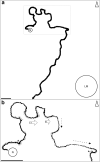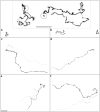Magnetosensation during re-learning walks in desert ants (Cataglyphis nodus)
- PMID: 34677637
- PMCID: PMC8918450
- DOI: 10.1007/s00359-021-01511-4
Magnetosensation during re-learning walks in desert ants (Cataglyphis nodus)
Abstract
At the beginning of their foraging careers, Cataglyphis desert ants calibrate their compass systems and learn the visual panorama surrounding the nest entrance. For that, they perform well-structured initial learning walks. During rotational body movements (pirouettes), naïve ants (novices) gaze back to the nest entrance to memorize their way back to the nest. To align their gaze directions, they rely on the geomagnetic field as a compass cue. In contrast, experienced ants (foragers) use celestial compass cues for path integration during food search. If the panorama at the nest entrance is changed, foragers perform re-learning walks prior to heading out on new foraging excursions. Here, we show that initial learning walks and re-learning walks are structurally different. During re-learning walks, foragers circle around the nest entrance before leaving the nest area to search for food. During pirouettes, they do not gaze back to the nest entrance. In addition, foragers do not use the magnetic field as a compass cue to align their gaze directions during re-learning walk pirouettes. Nevertheless, magnetic alterations during re-learning walks under manipulated panoramic conditions induce changes in nest-directed views indicating that foragers are still magnetosensitive in a cue conflict situation.
Keywords: Landmark panorama; Learning and memory; Magnetic compass; Navigation; Path integration.
© 2021. The Author(s).
Conflict of interest statement
The authors declare that they have no conflict of interest.
Figures





Similar articles
-
The role of learning-walk related multisensory experience in rewiring visual circuits in the desert ant brain.J Comp Physiol A Neuroethol Sens Neural Behav Physiol. 2023 Jul;209(4):605-623. doi: 10.1007/s00359-022-01600-y. Epub 2022 Dec 9. J Comp Physiol A Neuroethol Sens Neural Behav Physiol. 2023. PMID: 36494572 Free PMC article. Review.
-
The Geomagnetic Field Is a Compass Cue in Cataglyphis Ant Navigation.Curr Biol. 2018 May 7;28(9):1440-1444.e2. doi: 10.1016/j.cub.2018.03.043. Epub 2018 Apr 26. Curr Biol. 2018. PMID: 29706513
-
Species-specific differences in the fine structure of learning walk elements in Cataglyphis ants.J Exp Biol. 2017 Jul 1;220(Pt 13):2426-2435. doi: 10.1242/jeb.158147. J Exp Biol. 2017. PMID: 28679795
-
The Role of Celestial Compass Information in Cataglyphis Ants during Learning Walks and for Neuroplasticity in the Central Complex and Mushroom Bodies.Front Behav Neurosci. 2017 Nov 14;11:226. doi: 10.3389/fnbeh.2017.00226. eCollection 2017. Front Behav Neurosci. 2017. PMID: 29184487 Free PMC article.
-
Experimental ethology of learning in desert ants: Becoming expert navigators.Behav Processes. 2019 Jan;158:181-191. doi: 10.1016/j.beproc.2018.12.001. Epub 2018 Dec 5. Behav Processes. 2019. PMID: 30529645 Review.
Cited by
-
Integration and evaluation of magnetic stimulation in physiology setups.PLoS One. 2022 Jul 22;17(7):e0271765. doi: 10.1371/journal.pone.0271765. eCollection 2022. PLoS One. 2022. PMID: 35867646 Free PMC article.
-
The role of learning-walk related multisensory experience in rewiring visual circuits in the desert ant brain.J Comp Physiol A Neuroethol Sens Neural Behav Physiol. 2023 Jul;209(4):605-623. doi: 10.1007/s00359-022-01600-y. Epub 2022 Dec 9. J Comp Physiol A Neuroethol Sens Neural Behav Physiol. 2023. PMID: 36494572 Free PMC article. Review.
-
Through an animal's eye: the implications of diverse sensory systems in scientific experimentation.Proc Biol Sci. 2024 Aug;291(2027):20240022. doi: 10.1098/rspb.2024.0022. Epub 2024 Jul 17. Proc Biol Sci. 2024. PMID: 39016597 Free PMC article. Review.
-
Importance of magnetic information for neuronal plasticity in desert ants.Proc Natl Acad Sci U S A. 2024 Feb 20;121(8):e2320764121. doi: 10.1073/pnas.2320764121. Epub 2024 Feb 12. Proc Natl Acad Sci U S A. 2024. PMID: 38346192 Free PMC article.
-
Rotation of skylight polarization during learning walks is necessary to trigger neuronal plasticity in Cataglyphis ants.Proc Biol Sci. 2022 Jan 26;289(1967):20212499. doi: 10.1098/rspb.2021.2499. Epub 2022 Jan 26. Proc Biol Sci. 2022. PMID: 35078368 Free PMC article.
References
-
- Fleischmann PN, Christian M, Müller VL, Rössler W, WehnerR, Ontogeny of learning walks and the acquisition of landmark information in desert ants, Cataglyphis fortis. J Exp Biol. 2016;219:3137–3145. - PubMed
Publication types
MeSH terms
LinkOut - more resources
Full Text Sources

